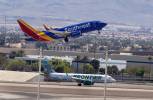Train trouble: Las Vegas Monorail fails to exit bankruptcy
Let the Las Vegas Monorail serve as a cautionary tale to all who see train-style transportation as a critical transit need — especially the backers of the planned DesertXpress line to Victorville, Calif.
The lesson: Construction debt, which tends to keep projects from penciling out, won’t simply go away.
On Friday, a federal judge slapped down the monorail’s plan to exit Chapter 11 bankruptcy because terms that took two years to negotiate merely prolong the route’s death.
Since the monorail began service in 2004, it has carried just enough riders to cover operational costs. But the company never collected enough revenue to pay interest and principal on the tax-exempt bonds sold to finance the line. How slim is the monorail’s margin? The reorganization plan reduced $658 million in debt to $40.4 million, and the 3.9-mile line still had no prayer of paying that back, let alone covering maintenance costs in the decade ahead.
“The monorail essentially asks the court to allow it to float along until it sinks, suggesting that when it ultimately sinks, the court need not concern itself with how creditors will make it onto the life raft — or even whether there will be a life raft available,” U.S. Bankruptcy Court Judge Bruce Markell wrote. “The court declines this invitation.”
The monorail’s plan for survival boiled down to finding a new group of investors brave enough to finance an extension to McCarran International Airport, receiving a federal bailout, or both. Hail Mary passes have better odds.
Perhaps the monorail will live on under different ownership — and not a local government takeover. The company lacks the money to demolish the line. If it’s ordered to cease operations, maybe a buyer would be willing to risk fractions of pennies on the dollar for the chance to run it. Without any debt, it might have a chance.
And that’s the big reason why so many advocates of high-speed rail insist that the federal government get behind large-scale train projects across the country, either through taxpayer-backed loans or giveaways. Unfortunately, Washington never worries about getting paid back. (Solyndra, anyone?)
But just last week, Congress voted to kill $8 billion President Obama had sought as a down payment on a nationwide high-speed rail network, largely because lawmakers realized such projects always cost far more than promised and quickly turn into money losers.
That hasn’t yet held back the DesertXpress proposal, a $6 billion, 200-mile, high-speed line that could start construction as soon as next year. Federal dollars have long been part of the project’s financing plan, along with private money.
The train has been compared to the monorail because of a route that appears to be limiting. At least taxpayers weren’t forced to invest in the monorail. We’d prefer the DesertXpress were funded exclusively by private investors as well. Washington has too big a balance on its credit card as it is.
We hope DesertXpress proves everyone wrong. If it doesn’t, future rail champions will have another cautionary tale to consider — one that makes the monorail seem minuscule by comparison.


















